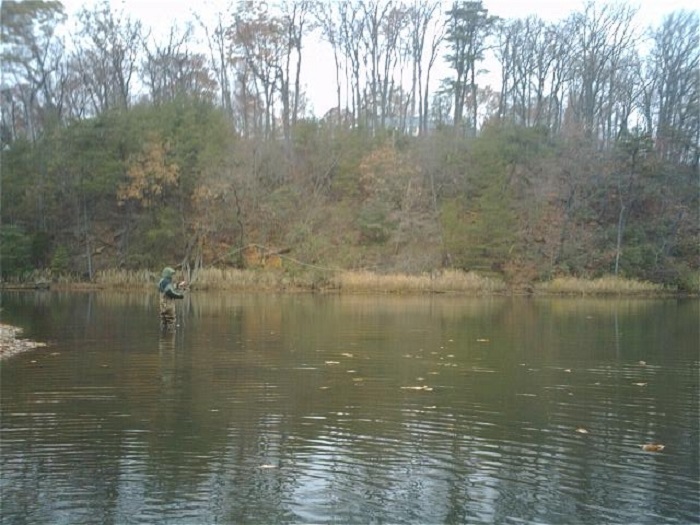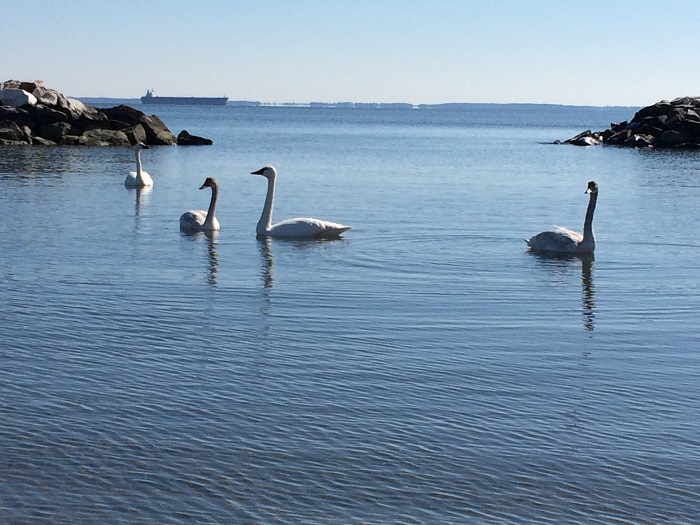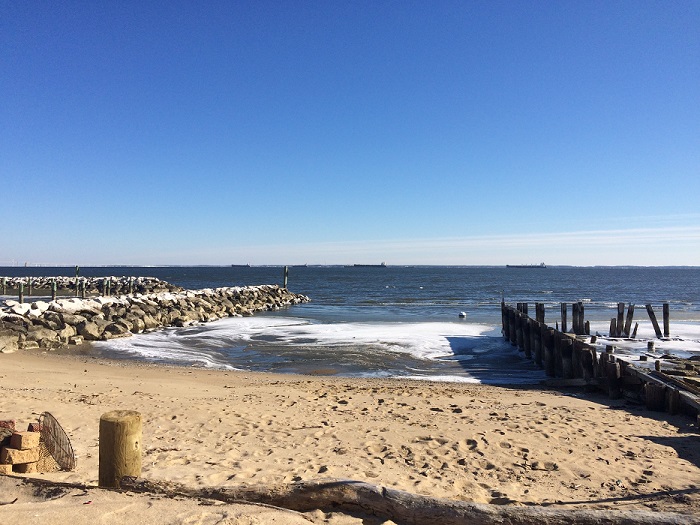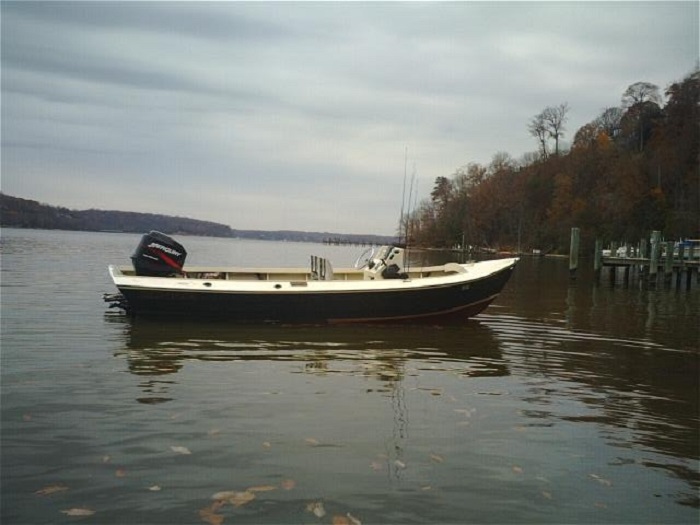
Winter Fishing is a Good Excuse for Progging the Chesapeake Bay and its Rivers
progging NOUN
(also proging, praggin, progueing)
- The action or process of foraging, delving; searching or hunting about, especially for timber or firewood (British regional), or for food (United States regional [especially Chesapeake Bay], Caribbean, Irish English). Also occasionally: the wood or food for which one forages.
Got winter cabin fever? The rivers of the Chesapeake Bay can help. Prudent cold weather fishing forms a great excuse to get outside with friends (don’t go alone at this season, and make sure you let someone know when you’ll be back). These quiet, crisp, winter days are a special time for walking shorelines; watching Canada geese, tundra swans, and ducks like buffleheads, plus maybe an eagle or two (they’re getting ready to nest) and great blue herons. Coffee from a stainless-steel thermos and oatmeal cookies supply necessary nutrition. Dress warm: this is the season to layer up with polypropylene, flannel, wool, fleece, Gore-Tex, and hip boots or waders. Pay careful attention to your heat-loss areas: head, neck, wrists (surprising how much we can lose there—or keep), and hands.
 Courtesy of VisitMaryland.org
Courtesy of VisitMaryland.orgWater temperatures are 38-450 F., so cold-blooded critters like fish have slowed ‘way down, but others that can generate their own metabolic heat--water birds and mammals like muskrats, raccoons, and river otters--are active. Low winter tides expose the bare bones of the rivers and creeks. Learn to look closely and you’ll be amazed at how much you see.
Smith and Tangier Islanders refer to this sort of expedition as progging, pronounced with a long o. And despite the definition above from the Oxford English Dictionary, the process isn’t necessarily just about food or firewood. It’s really about focus. The best proggers in those islands are experts at careful looking, opening all their senses to whatever they find, from useable old crab pot floats and sea glass shards to arrowheads and otter tracks.
The lesson from the island proggers is important at any season, but now, in winter, when the cold strips away the obvious visible activities of blue crabs and peanut menhaden, we have to look for more subtle clues, like a diagonally chopped-off cordgrass stem floating at the edge of a marsh. Ever seen a muskrat’s front teeth? That’s the kind of cut they make. Ever chew the sweet, soft base of a cordgrass stem? That taste explains why. You might even find one of these furry little steamboats chugging toward you on the surface, before it dives to escape.
 Courtesy of VisitMaryland.org
Courtesy of VisitMaryland.orgIf the tide is ‘way out, you may find yourself pondering mysteries like why a raccoon has walked out on the wet sand, leaving clear tracks, to dig a crater in the bottom. Look closely and you may find white scraps of a thumbnail-sized clam shell, probably the Baltic clam (Macoma balthica), which has no direct value to us humans but represents important protein for the neighborhood’s coons and seagulls at low water, and for multiple duck species and tundra swans when the tide comes back in.
Except for swans and Canada geese, winter’s wildlife usually don’t advertise their presence. Herons, for example, hunch down to retain body heat, but they are still watching the water around them carefully. Their legs and feet don’t have a lot of blood vessels, so they can stand in cold water more or less comfortably. Think about how they pick their roosting and fishing spots, though. On sunny days, they hang out along shallow, south-facing shores where the water temperature can be a degree or two above the rest of the river, especially in the afternoon. Watch long enough and you may see the bird suddenly go to full alert. It may be coiling that long, powerful neck and sharp beak to strike a bull minnow (killifish). The warmer water draws in these little fish too. Binoculars are handy for this kind of progging.
[gallery link="none" columns="1" size="full" ids="8131"]
The stocky, ubiquitous bull minnows are remarkable themselves. One-to-four inches long, they come in three closely-related species, all of which can withstand a very wide range of water temperature extremes. They thrive in shallow, summertime marsh pools where the temperature tops 1000 F., but they can also withstand, at least for short periods, being trapped in ice. They eat bits and scraps of the decaying plant and animal material that collects along shorelines, and there aren’t many carnivorous aquatic critters that don’t eat them, in turn, especially in winter.
So yes, they make good bait. Fishing? Oh, right, that’s why we came out here, isn’t it? Our traditional winter target is that fierce attack predator, the chain pickerel. These fish prowl the same shorelines along rivers and creeks, looking for bull minnows and anything else that will fit into their toothy mouths. Expert angler Jim Gronaw offers serious advice about them on Fish & Hunt MD at https://fishandhuntmaryland.com/target-winter-chain-pickerel/. You might find some bonus species, like white perch (think firm fillets for great tacos!), yellow perch, and, in this rainy year, channel cats (also for tacos!). Maybe even a rockfish will strike (a must-release, with their season closed).
 Courtesy of John Page Williams
Courtesy of John Page WilliamsAs to boats: canoes, kayaks, and skiffs make good wade-fishing taxis, but wear inflatable life vests underway, and pick your weather. This is no time to act heroic. If your skiff or kayak has good sonar, jigging and bait fishing may be worth a try. At the least, it’ll let you do a little fish-watching (consider it a 21st-century addition to the progger’s tools). Look for white perch and cats in 35-40’-deep holes next to 10-18’-deep restoration oyster reefs. That positioning lets them rest in the warmest, most stable water mass in the river, but close by the “live bottom” of a reef when they need to feed. Try bloodworms on hi-lo rigs, w/ 1-2” soft plastic teasers on the hooks as well. If you see them on the sonar but they aren’t biting, make sure you take note of the spot for another trip. You may also see a bait ball of menhaden that decided to stay put for the winter instead of risking the phalanx of predators that would have faced them migrating south. Yes, there’s still life down there!
When you get home, be sure to warm up and go back over your day with those fishing friends and something toasty to eat or drink, preferably beside a crackling fire. This is where the best stories get crystallized into the memories that last for years.
Good Winter Fishing Information Sources:
- Where to go: Maryland National and State Parks https://www.visitmaryland.org/list/national-and-state-parks
- Tackle Shops—Anglers (anglerssportcenter.com), AllTackle (alltackle.com), Marty’s (martysfishing.com)
- Magazines/Web Sites: com, Wild Chesapeake at ChesapeakeBayMagazine.com, Department of Natural Resources Fisheries pages, eyesonthebay.net (under Fishing, choose Click Before You Cast)
- Book: Chesapeake Bay Panfish (chesapeakelighttackle.com, available online and at the tackle shops)
- Fishing Journal- http://dnr.maryland.gov/fisheries/Pages/recreational/Anglers_log.aspx
- Fishing Reports- http://dnr.maryland.gov/Fisheries/Pages/fishingreport/index.aspx
This post was written by John Page Williams
Images courtesy of the author and VisitMaryland.org